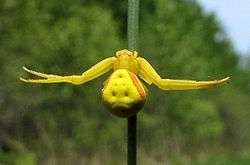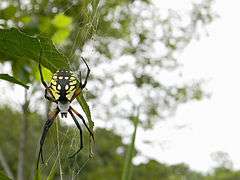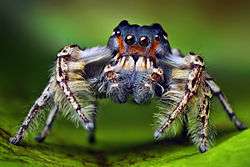Sexual selection in spiders
Sexual selection in spiders shows how sexual selection explains the evolution of phenotypic traits in spiders.[1] Male spiders have many complex courtship rituals and have to avoid being eaten by the females, with the males of most species survive a few matings, and having short life spans.
Pre-copulatory mate choice processes have been observed in a wide range of spider species, including Stegodyphus lineatus, Argiope aurantia, Schizocosa floridana, Hygrolycosa rubrofasciata, and Schizocosa stridulans.[2][3][4][5][6]
Sexual selection occurs after copulation as well as before copulation.[7] Post-copulatory sexual selection involves sperm competition and cryptic female choice. Sperm competition occurs when the sperm of more than one male competes to fertilize the egg of the female. Cryptic female choice involves the expelling of a males sperm during or after copulations.[8]
Male to male competition


_female.jpg)
Size is a factor in the reproductive success of males with species such as Stegodyphus lineatus, Argiope aurantia and Argyroneta aquatica showing sexual dimorphism, beneficial for larger males, stronger and more aggressive, who fight off the smaller ones using their large chelicerae and forelegs.[2][9] This leads to a decrease in the paternal success for smaller males since they are unable to gain access to females.[10] In Argiope aurantia males can lose legs in combat, with the loss more prevalent in smaller maless, evidence that larger males arre favored in male-to-male competition.[3] In the water spider Argyroneta aquatica, where males and females permanently live in the water[11] the males are larger, indicating sexual selective pressures for large body size. The large male water spiders are more mobile, helping them obtain more females.
Sexual selection provides benefits to smaller male spiders under certain conditions, such as Misumena vatia and Nephila clavipes, whose smaller males climb faster to reach their mates:[12][13] Explained by the gravity hypothesis,[12] outcompeting larger males thus having more reproductive success,[13] especially when females live in high patches of flowers,[13] whereas females live in low lying areas, larger males are favored.[3]
In spiders like Tetragnathidae, Araneidae, Thomisidae and Pholicidae[12] there is an optimal body size that favors climbing speed. Smaller males will have an advantage over the largest males of the species, however the smallest male will not be the fastest climber.[13] This optimal body size for climbing is observed in different
Males from the same species express phenotypes, weapons such as chelicerae, teeth or even legs to fight off competition are used to fight off oncoming rivals, with larger bodied spiders contained larger chelicerae.[9] In most cases body size correlated with mating success.[2] This isobserved in Lysommanes viridis, whose males display weapons that are very pronounced in comparison with females and selected to help males fight off competition.[9]
The time it takes to develop is crucial to the overall fitness of a spider. This idea is true, however does not mean that larger males will always have better fitness. In Latrodectus hasselti, larger males outcompete smaller males by getting to the females web first. However, these large male spiders have long development times, meaning that the larger male will need more time before being able to copulate. Smaller males tend to have a quick development time which gives them an advantage in mating with a female. This advantage correlates with high paternal success in the species Latrodectus hasselti. Larger males are able to outcompete smaller males, but not able to mate. Smaller males risk getting outcompeted, but are more likely to have paternal success.[14]
Sperm competition

Sperm competition occurs in many species, such as Unicorn catleyi, Nephila Pilipes and Argiope aurantia,[15][16][17] with males acting to limit it by guarding the female or inserting parts of the male genitalia into the females reproductive organs,[7] or using mating plugs[18] which come from the males seminal fluid.[19] This process is observed in the species Unicorn catleyi, for example.[15] In this species, males plug a females insemination duct with a portion of their palp that contains the ejaculatory duct called the embolus. The embolus that is found in the female's posterior receptaculum suggests that males are trying to limit sperm competition.[15]
In some spider species, such as the Nephila pilipes, multiple males try to mate with only one female. This can be harmful to the female, because it forces her to participate in energy costly matings. In response to this polyandry, the female produces mating plugs of her own to prevent too many males from copulating with her.[18]
The mating plugs transferred to females by the males are believed to be a possible cause of monogyny.[17] For example, in the spider species Argiope aurantia, males will sometimes plug a female with both pedipalps to prevent sperm competition. When this occurs, the male loses his ability to mate with more than one female.[17]
Mate choice

Mate choice is typically displayed by females, but males can be choosy as well.[1] Traits associated with winning competitive bouts are more likely to be chosen by females. As body size effects male-to-male competition, females will choose the male with the more efficient body size. A Wolf spider, Schizocosa floridana, females assess males based on their ability to cope with a changing environment, observing the way males adapt to differences in food availabilities at different times. Males who are able to adapt to the changes in food availability are well conditioned and usually show courtship displays such as tapping on their forelegs and waving. females choose the males who express these courtship displays and are larger in size based on predictions of the males foraging past.[4]
Courtship displays are commonly expressed in individuals of a species to display are signals used to attract the opposite sex, such as degrees of ornamentations, colors and movements. The male Hygrolycosa rubrofasciata spider displays certain signals, known as drumming, where a male taps his legs on a rough surface such as a leaf to signal he is ready to mate,[5] with its speed influencing female choice towards faster drummers. Once the females chooses the male, her body starts to shake, a signal that she is ready to mate too. Males who exhibit better drumming behavior typically are more viable.[5]
Schizocosa stridulan males have ornamentation traits in their forelegs[6] which affect their mating success. When courtship rates are high, ornamentation does not increase the reproductive rates of males because of the correlation between the aggressiveness of a spider and the degrees of ornamentation. Due to this correlation it is hypothesized that females choose males without ornamentation to avoid aggression from the males. Females are able to be choosy when courtship rates are high because they do not have to worry about missing out on copulations if there are plenty of male spiders to mate with. When courtship rates are low, males with high degrees of ornamentation are able to get to the female more quickly, thus giving them an advantage over non ornamented males.[6]
Sometimes facial color or leg brightness can play a role in mate choice. In several species of jumping spiders, including Habronattus pyrrithrix, and Cosmophasis umbratica, males show different brightness and color of body parts prior to copulation.[20] These colors can be used to the males advantage in attracting a mate. In the species Habronattus pyrrithrix, the males who have faces that are red and non bright green legs are more likely to attract a mate than males who do not, indicating that females prefer males with those particular traits.[20]
Although females from the species, Hygrolycosa rubrofasciata, Schizocosa floridana and Schizocosa stridulans tend to be the choosier sex, it is not uncommon to observe males from different spider species such as the Zygiella x-notata and Latrodectus hesperus, to be choosy as well.[4][5][6][21][22] In the orb weaving spider Zygiella x-notata, reproduction rates are affected by male choice under different conditions.[21] These external conditions depend on the amount of competition between males of the species. When competition rates are low, males mate opportunistically with as many females as possible.[21] When competition between males is high, larger males choose to mate with a large female as opposed to the smaller males who choose to mate with any female. The belief is that the advantages of larger size in competition, will give the larger males an opportunity to increase their paternal success by allowing them to be more selective of females.[21]
Sometimes males choose females who are large and better conditioned to avoid being eaten. Choosing a mal-nourished female can result in a male being cannibalized before copulation.[22] Cannibalism by females is often expressed as a way for females to get nutrition from their mates after copulation.[23] This cannibalistic behavior by females makes males more selective with whom to mate with. The males from the species Latrodectus hesperus show high mate preference for better conditioned females. By choosing well nourished females, males are able to increase their mating success while limiting their chance of being consumed. This is because well nourished females are less likely to eat their mates than mal-nourished females.[22]
Cryptic female choice
Cryptic female choice is a post-copulatory process of mate choice.[8] This process is observed in numerous spider species such as, Physocyclus globosus and Argiope bruennichi.[8][24] For example in the Argiope bruennichi species, males produce energetic courtship displays prior to copulation. Regardless of the displays, females are observed to mate with multiple males. Once copulation is over the offspring of the female is more likely to have the courtship display phenotype than not. The females of this species must be cryptically discarding sperm from the non courtship males while keeping the other males sperm for copulation.[24] This allows females to mate with as many males as she wants prior to copulation, while being more choosy of males after copulation. Discarding the sperm of a male who does not perform courtship displays indicates that females feel that males who perform courtship displays have the greatest fitness.[24]
References
- 1 2 Buss, D. M. The evolution of human intrasexual competition: tactics of mate attraction. Journal of personality and social psychology 54, 616–28 (1988).
- 1 2 3 Maklakov, A. a., Bilde, T. & Lubin, Y. Sexual selection for increased male body size and protandry in a spider. Animal Behaviour 68, 1041–1048 (2004).
- 1 2 3 Foellmer, M. W. & Fairbairn, D. J. Competing dwarf males: sexual selection in an orb-weaving spider. Journal of evolutionary biology 18, 629–41 (2005).
- 1 2 3 Rosenthal, M. F. & Hebets, E. a. Resource heterogeneity interacts with courtship rate to influence mating success in the wolf spider Schizocosa floridana. Animal Behaviour 84, 1341–1346 (2012).
- 1 2 3 4 Kotiaho, J., Alatalo, R. V, Mappes, J. & Parri, S. SEXUAL SELECTION IN A WOLF SPIDER : MALE DRUMMING ACTIVITY , BODY SIZE , AND VIABILITY. 50, 1977–1981 (1996).
- 1 2 3 4 Hebets, E. A., Stafstrom, J. A., Rodriguez, R. L. & Wilgers, D. J. Enigmatic ornamentation eases male reliance on courtship performance for mating success. Animal Behaviour 81, 963–972 (2011).
- 1 2 Eberhard, W. G. Postcopulatory sexual selection: Darwin’s omission and its consequences. Proceedings of the National Academy of Sciences of the United States of America 106 Suppl , 10025–32 (2009).
- 1 2 3 Peretti, a V & Eberhard, W. G. Cryptic female choice via sperm dumping favours male copulatory courtship in a spider. Journal of evolutionary biology 23, 271–81 (2010).
- 1 2 3 Tedore, C. & Johnsen, S. Weaponry, color, and contest success in the jumping spider Lyssomanes viridis. Behavioural processes 89, 203–11 (2012).
- ↑ Maklakov, A. a. & Lubin, Y. Indirect genetic benefits of polyandry in a spider with direct costs of mating. Behavioral Ecology and Sociobiology 61, 31–38 (2006).
- ↑ Schutz, D. & Taborsky, M. Sexual Selection in the Water Spider: Female Choice and Male-Male Competition. Ethology 117, 1101–1110 (2011).
- 1 2 3 Moya-Laraño, J., Vinković, D., Allard, C. M. & Foellmer, M. W. Optimal climbing speed explains the evolution of extreme sexual size dimorphism in spiders. Journal of evolutionary biology 22, 954–63 (2009).
- 1 2 3 4 Moya-laraño, A. J., Halaj, J. & Wise, D. H. Climbing to Reach Females : Romeo Should be Small. 56, 420–425 (2001).
- ↑ Kasumovic, M. M. & Andrade, M.C.B.A change in competitive context reverses sexual selection on male size. Journal of evolutionary biology 22, 324–33 (2009).
- 1 2 3 Izquierdo, M. a & Rubio, G. D. Male genital mutilation in the high-mountain goblin spider, Unicorn catleyi. Journal of insect science (Online) 11, 118 (2011).
- ↑ Zhang, S., Kuntner, M. & Li, D. Mate binding: male adaptation to sexual conflict in the golden orb-web spider (Nephilidae: Nephila pilipes). Animal Behaviour 82, 1299–1304 (2011).
- 1 2 3 Foellmer, M. W. Broken genitals function as mating plugs and affect sex ratios in the orb-web spider Argiope aurantia. evolutionary ecology research 10, 449–462 (2008).
- 1 2 Kuntner, M., Gregorič, M., Zhang, S., Kralj-Fišer, S. & Li, D. Mating plugs in polyandrous giants: which sex produces them, when, how and why? PloS one 7, e40939 (2012).
- ↑ Aisenberg, A. & Barrantes, G. Sexual behavior, cannibalism, and mating plugs as sticky traps in the orb weaver spider Leucauge argyra (Tetragnathidae). Die Naturwissenschaften 98, 605–13 (2011).
- 1 2 Taylor, L. a., Clark, D. L. & McGraw, K. J. Condition dependence of male display coloration in a jumping spider (Habronattus pyrrithrix). Behavioral Ecology and Sociobiology 65, 1133–1146 (2010).
- 1 2 3 4 Bel-Venner, M. C., Dray, S., Allainé, D., Menu, F. & Venner, S. Unexpected male choosiness for mates in a spider. Proceedings. Biological sciences / The Royal Society 275, 77–82 (2008).
- 1 2 3 Johnson, J. C., Trubl, P., Blackmore, V. & Miles, L. Male black widows court well-fed females more than starved females: silken cues indicate sexual cannibalism risk. Animal Behaviour 82, 383–390 (2011).
- ↑ Wu, L., Zhang, H., He, T., Liu, Z. & Peng, Y. Factors influencing sexual cannibalism and its benefit to fecundity and offspring survival in the wolf spider Pardosa pseudoannulata (Araneae: Lycosidae). Behavioral Ecology and Sociobiology 67, 205–212 (2012).
- 1 2 3 Schneider, J. M. & Lesmono, K. Courtship raises male fertilization success through post-mating sexual selection in a spider. Proceedings. Biological sciences / The Royal Society 276, 3105–11 (2009).